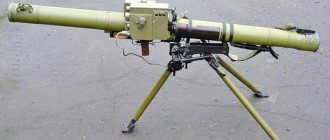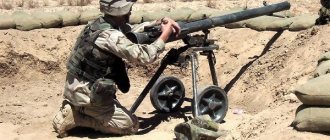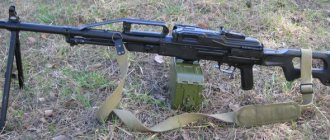LiveInternetLiveInternet
Warhead tandem Caliber, mm 105 Weight, kg: grenade launcher 11.5 rounds 6.7 Aimed firing range, m 500 Thickness of the barrier penetrated, m: homogeneous armor after overcoming DZ 0.6+ reinforced concrete and brick 1.5+ wood-earth 3.7+
Designed to combat tanks of all types, including those equipped with dynamic protection, and other armored vehicles, suppressing firing points and manpower in buildings and structures. Reusable grenade launcher. Equipped with mechanical, optical and night sights. The complex is based on a 105-mm shot with a tandem warhead. The main difference between the PG-29V round and those previously used in second-generation hand-held anti-tank grenade launchers is the absence of a propellant (starting) charge in its composition. The grenade receives its propulsion from a jet engine, which operates only within the length of the grenade launcher's barrel. The PG-29V shot engine can be made in two versions (with a fiberglass or steel chamber) and provides the initial speed for firing. The absence of an active part of the trajectory—the engine stops working before departure—has simplified the rules for taking into account corrections for side winds. The tandem warhead of the PG-29V shot has two parts - the front (precharge) and the main, connected to each other by a tube. The action of the warhead of the PG-29V round is similar to the warhead of the PG-7VR round. When the front warhead hits the DMZ, it initiates an explosive attack; the DMZ plates fly apart and act on the cumulative precharge jet. At the same time, the fuse of the main warhead begins to function. The main purpose of the PG-29V round is to destroy tanks with dynamic protection. In addition, it can be effectively used to suppress firing points and defeat enemy personnel located in buildings and structures made of brick or reinforced concrete, and wood-earth shelters. The design of the PG-29V jet engine is similar to the RPG-27 grenade engine, but its powder charge is ignited by an electrical impulse from the trigger mechanism generator. The shot has two main parts: a tandem warhead and a jet engine with a stabilizer. An electrical impulse is supplied to the electric igniter of the reactive charge through an electrical circuit through a contact ring on the grenade stabilizer. A similar charge ignition scheme is used in the SPG-9 and RPG-16 grenade launchers. When a certain pressure is reached in the engine chamber, the forcing unit is pushed back, the stabilizer is released from the contact sleeve and the grenade begins to move. The jet engine operates only within the length of the grenade launcher barrel, then the grenade flies by inertia. Stabilization of the grenade's flight is ensured by eight stabilizer blades, which open after the grenade takes off under the action of springs and the oncoming air flow. To monitor the flight of the grenade and adjust the fire, the grenade has a tracer. The RPG-29 grenade launcher in the stowed position (disconnected) consists of two parts and is carried in a pack on a belt. The RPG-29 is transferred to the firing position by connecting the pipes with a rotary coupling. The grenade launcher has a folding bipod. An open mechanical sight is mounted on the barrel. The main sight is a 1P38 optical sight with a field of view of 13° and a magnification of 2.7x. The RPG-29 grenade launcher can be equipped with a 1PN51-2 night sight. In this case, it is designated RPG-29N. The combat rate of fire of a grenade launcher when served by two crew numbers - the grenade launcher and his assistant - reaches 4 rounds per minute. The mass of the grenade launcher with an optical sight is 12.1 kg. The RPG-29 with the PG-29V round was adopted for service in 1989. In 1993, it was first presented at the international arms exhibition IDEX-93 in Abu Dhabi. The PG-29 grenade penetrated a 300 mm armor barrier with a remote sensing unit installed at an angle of 60° (i.e. 600 mm along the course of the cumulative jet).
Design of RPG-7
The design of the RPG-7 grenade launcher is extremely simple. It consists of a barrel (essentially a pipe), with an optical and mechanical sight installed on it, a trigger mechanism and a firing pin. We can say that this is a smooth-bore recoilless rifle. According to the instructions, the RPG-7 must be fired from the shoulder, so a heat-insulating casing is installed in the middle part of the grenade launcher. On the back side of the grenade launcher there is a nozzle for more efficient removal of powder gases when fired.
RGP-7 has two handles: the front one comes in conjunction with the trigger mechanism, and the rear one is made for more comfortable holding of the weapon. When fired, the firing pin hits the primer, which, in turn, ignites a small powder charge, which pushes the grenade out of the barrel and gives it a rotational movement.
After leaving the grenade launcher tube, the grenade's stabilizers open and the charge of its main jet engine ignites. It should be noted that the jet engine starts working at a safe distance from the grenade launcher. After leaving the barrel, the grenade fuse is cocked.
The grenade's jet engine accelerates it at the initial stage of its trajectory to a speed of 300 m/s; after it burns out, the grenade flies by inertia. If it does not encounter any obstacle on its way, then after a distance of 1000 meters the self-destruct device is triggered and the grenade explodes.
Since the grenade launcher is designed using a recoilless design, it has virtually no recoil. Powder gases flow back through the weapon's nozzle, and this balances the recoil force when fired.
At first, the RPG-7 grenade launcher had a PGO-7 optical sight with a range scale, as well as marks for making lateral corrections. However, in the mid-60s, the grenade launcher was equipped with a more advanced PGO-7V sight. Models equipped with these sights were designated RPG-7V.
History of the creation of the RPG-29
In the mid-eighties, SNPP Basalt began developing the RPG-29 Vampire project. The project was headed by V.S. Tokarev. It was supposed to create a grenade launcher that could hit modern as well as promising enemy tanks.
The main task of the designers was to create a rocket-propelled grenade that would effectively destroy armored vehicles equipped with dynamic protection systems. By solving this problem, it was possible to significantly increase the firepower of an infantry unit armed with a new grenade launcher.
The RPG 29 grenade launcher was adopted by the Soviet army in 1989 with the PG-29V cumulative grenade.
Description of the RPG-18 device
The grenade launcher's launcher is similar to the M72 system; its barrel consists of two pipes connected telescopically. Inside the fiberglass pipe there is a pipe made of aluminum alloy.
The upper tube is made of T13 grade fiberglass, which is impregnated with EP-5122 varnish. For the inner pipe, aluminum alloy 65KhZAMg6M or 65KhZD1T was used. the pipes in the stowed position are located one inside the other, they are 705 mm long. To fire a shot, the pipes move apart to form a barrel with a total length of 1050 mm.
The grenade is secured with stoppers in the inner tube; it consists of steel plates with a cutout, which are placed on two stabilizer feathers. At the other end of the plate, their bend is linked to the cut end of the barrel.
The firing process is as follows:
- To transfer the “Fly” to the combat position from the traveling position, open the back cover, then push the pipes all the way. The front cover will open, and the front sight and safety post with diopter will take a vertical position.
- The front sight has a frame made of glass with printed numbers and marks 5, 10, 15, 20, they represent the firing range of 50, 100, 150 and 200 meters. There are horizontal strokes on both sides at the level of the top point of the “15” aiming mark; they can be used to determine the distance to the tank. The distance is determined as follows: if the horizontal lines are the width of the frontal projection of the tank hull, then 150 m remains to the target.
- if the horizontal strokes are smaller than the width of the frontal projection of the tank hull, then less than 150 m will remain to the target.
- if the horizontal strokes are greater than the width of the frontal projection of the tank hull, then more than 150 m will remain to the target.
The locking mechanism, which is located on the inner tube at the rear of the body, serves as a locking mechanism for the striking mechanism in the stowed position, this prevents the igniter primer from breaking when the tubes are folded. In addition, the locking mechanism prevents a shot if the pipes are not completely retracted; in the firing position, it blocks the fixation of the pipes. The locking mechanism thus ensures safety when moving the pipes apart.
RPG-29 Vampire grenade launcher. Firing range. Weight. Dimensions
RPG-29 "Vampire" (TKB-0175, GRAU index - 6G20) - Soviet hand-held anti-tank grenade launcher. This is a modern weapon for a motorized rifle squad to destroy all types of modern tanks, armored and unarmored vehicles, as well as manpower in various types of defensive structures.
Combat use of RPG-7
For the first time, the RPG-7 took an active part in combat operations in Vietnam. His debut turned out to be very successful. The target firing range of the RPG-7 is 330 meters. During the Chechen campaign, the tactics of attack by Chechen separatists on federal troops were based on the use of grenade launchers. To date, due to improved tank protection (multi-layer armor, dynamic protection, active protection), the effectiveness of hand grenade launchers has decreased somewhat, especially for older types of grenades. For example, in Iraq, American and British tanks endured up to 15 grenade hits without breaking through the armor.
One of the design features of the RPG-7 is that the jet blast hits everything that is behind the shooter, therefore, according to the instructions, the fighter must make sure that there are no people behind him. However, this disadvantage is typical for any type of recoilless rifle.










